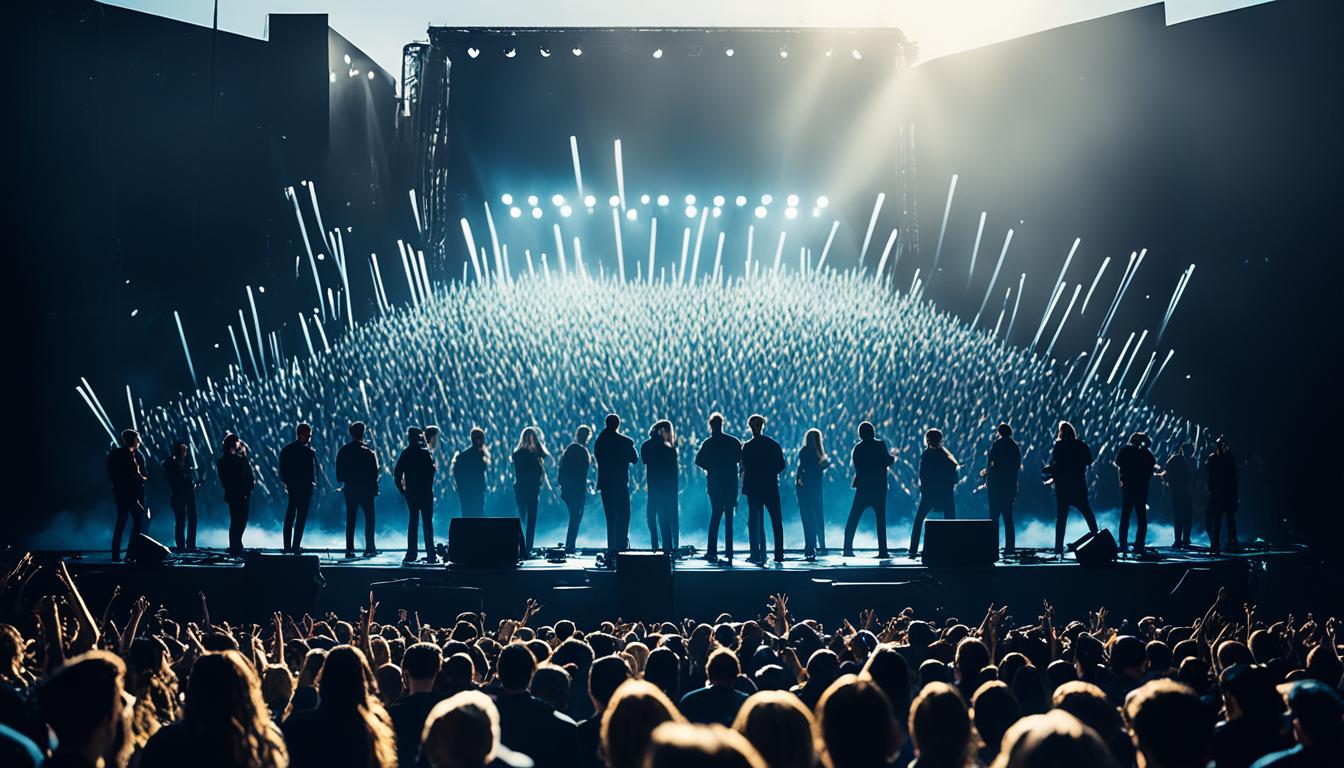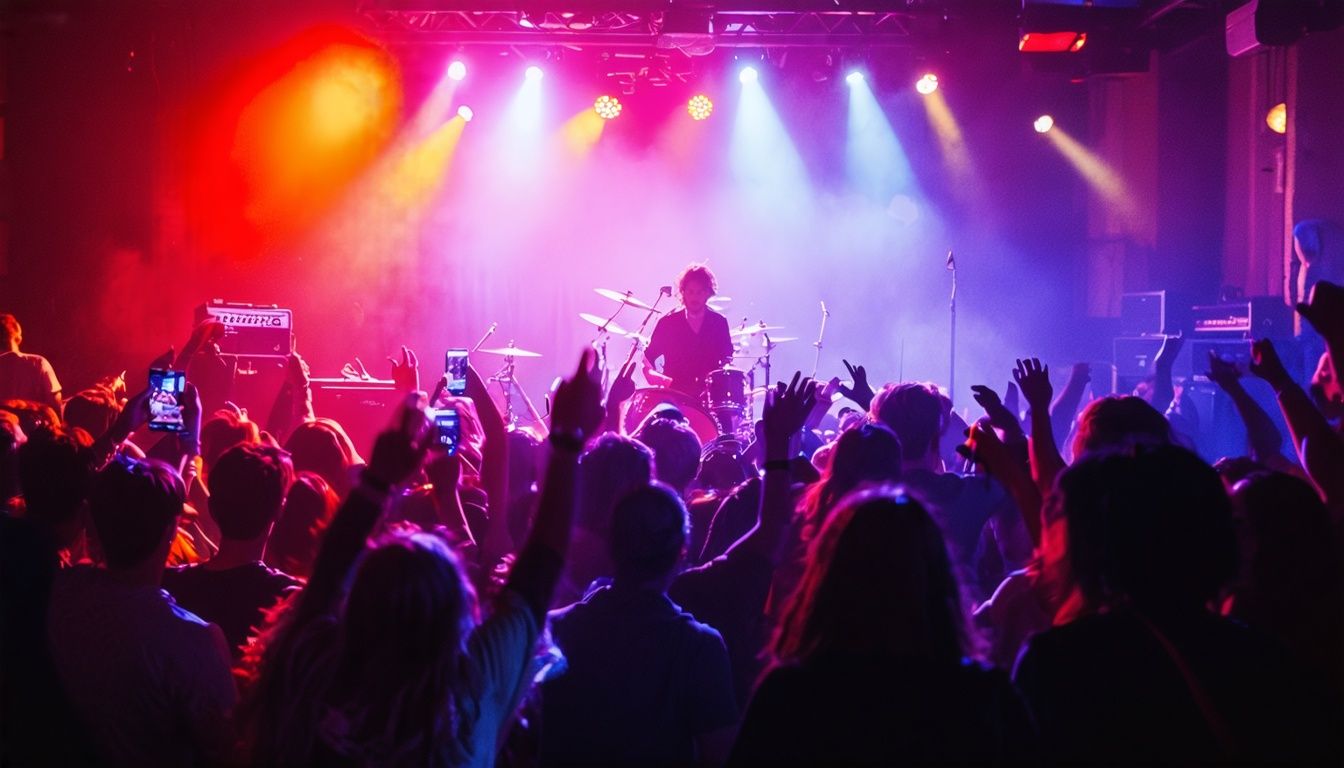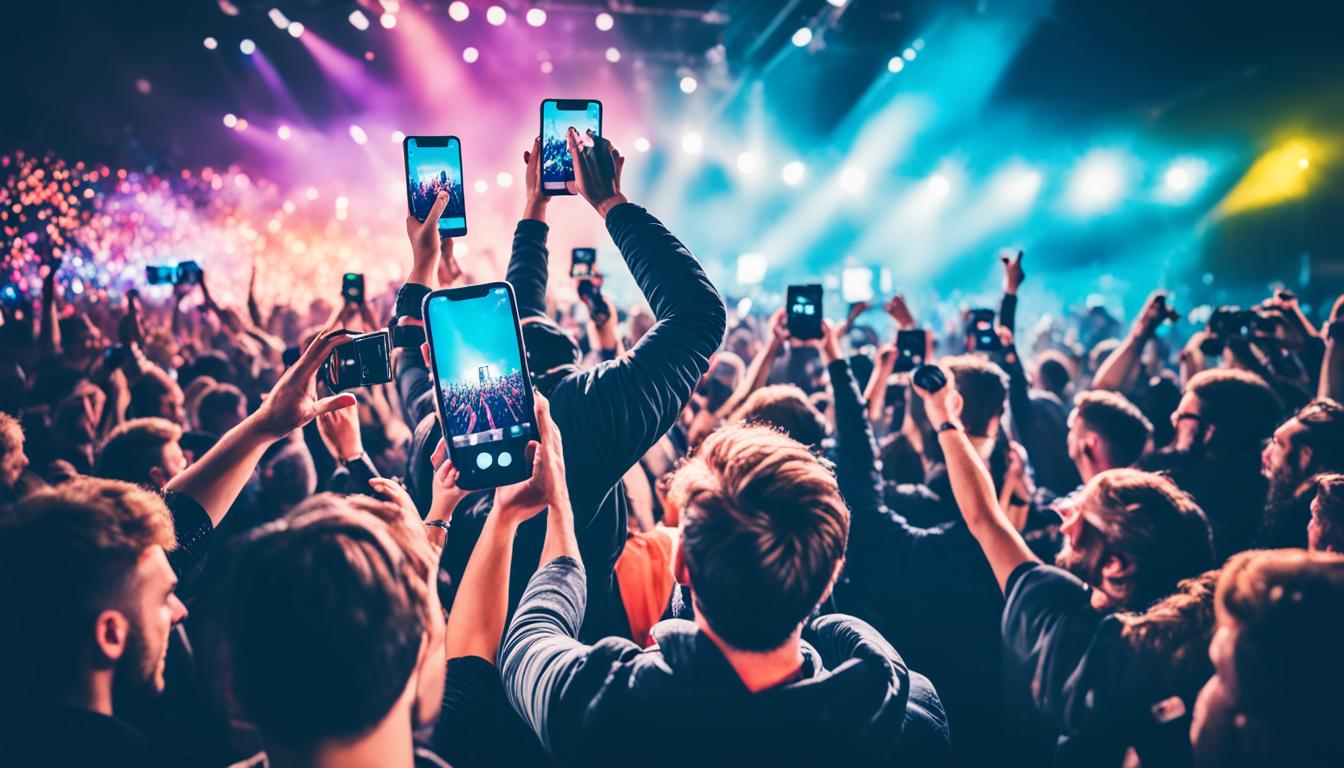We’ve all felt the electric charge of a live performance. Every beat vibrates through the air and into our bones. Outdoor concert photography comes with its challenges. They’re an essential part of the craft, demanding our full attention and skill.
Capturing movement in concert photography is thrilling yet demanding. We strive to translate the atmosphere of a music festival through our lens. It’s about taking more than a picture—it’s about capturing an experience.
As we move through crowds and dynamic stage lights, our aim is to create a memento. A piece that echoes the festival’s pulse. These tips are a guide for both seasoned pros and new photographers in the music festival scene.
Key Takeaways
- Understanding the dynamic nature of outdoor concert photography enhances the ability to capture lively performances.
- Employing the right camera settings is crucial for overcoming low-light conditions.
- A proactive approach to camera positioning can mitigate the unpredictability of live events.
- Mastering manual modes ensures greater control and creativity in capturing the ambiance.
- Having a selection of the appropriate gear, including fast lenses, will significantly improve the outcome.
- Patience and persistence are key in overcoming the challenges and achieving stunning concert visuals.
Understanding Outdoor Concert Photography
To truly appreciate concert photography, one must feel the live music’s vibe. We try to catch the energy of performances and make it last forever. The right camera settings help us tell the story of these lively sound events.
The Allure of Live Music Events
The excitement of live music is both heard and seen. The mix of stage lights and artists’ emotions is captivating. As photographers, we’re drawn to every detail, turning them into art with our skills.
Essential Photography Skills for Dynamic Environments
Getting the camera settings right for concerts is like making music. Everything must work together to tell a visual story. We need to know about aperture, shutter speed, and ISO to deal with changing light at outdoor concerts.
| Camera Setting | Concert Scenario | Recommended Settings |
|---|---|---|
| Aperture | Dramatic Solo Performance | f/2.8 to capture detail with a shallow depth of field |
| Shutter Speed | Dynamic Full Band Display | 1/200 to freeze motion without blur |
| ISO | Sundown Acoustic Set | 1600+ to compensate for low light while minimizing noise |
As we explore different concerts, we become better at using our cameras. We get good at knowing how the music and light will change. This skill is key for outdoor concert photography.
The Challenges of Outdoor Concert Photography
Outdoor concert photography brings its own set of unique tests. At the top is dealing with low light. This makes us use low light photography techniques skillfully. It’s not just about higher ISO. It’s about knowing how shutter speed, aperture, and sensor work together in low light.

Then, we face the challenge of overcoming crowd obstacles in photography. A crowded concert can be a problem or an opportunity. It’s about predicting movement on stage and in the crowd. Keeping calm and having a keen eye is vital for capturing that special moment.
Mastering the outdoor concert photography challenges allows us to find beauty in the chaos. Our photos tell stories, capturing moments and emotions in vibrant colors. It’s a mix of careful planning and being ready for anything that helps us capture the essence of outdoor concerts.
| Challenge | Approach | Benefit |
|---|---|---|
| Low Light Scenarios | Master manual settings; Utilize fast lenses; Embrace high ISO performance | Crisp images with authentic concert atmosphere |
| Crowded Spaces | Anticipate action; Position strategically; Be patient and adaptable | Dynamic shots that portray audience energy |
| Unpredictable Movement | Fast shutter speeds; Continuous shooting mode; Predict patterns | Vivid, sharp representations of live performances |
Diving into concert photography rewards us in many ways. Each photo is like a symphony, every challenge, a chance to grow. With our cameras and passion, we create visual anthems that capture the electric feel of live music.
Mastering Camera Settings for Concerts
As experienced photographers, we know the right camera gear is key for amazing concert photos. Stages are usually dim and actions are fast. It’s important to understand our gear and how to adjust it for live shows.
Best Camera Settings for Concert Photography
For concert photos, it’s crucial to balance aperture, shutter speed, and ISO. A wide aperture lets in a lot of light. So, use the lowest f-number your lens allows, like f/2.8. We aim for a shutter speed of at least 1/250th to capture movement clearly.
Don’t hesitate to increase the ISO for better exposure. Cameras like the Nikon Z 9 handle high ISOs well and keep the noise low.
Adapting to Low Light Conditions with Manual Modes
Using manual mode is essential for concert photography. It lets us control the exposure by adjusting settings as the music changes. This way, we can handle the varying light levels and ensure our photos capture the show’s energy.

While auto modes are useful at times, nothing beats a photographer’s touch in manual. Adjusting ISO, aperture, and shutter speed on the go is crucial. It lets us turn low light into stunning shots of the performance.
Here’s a simple guide for camera settings at concerts:
| Camera Gear/Setting | Recommended for Concert Photography | Notes |
|---|---|---|
| Aperture (f-number) | f/2.8 | Allows maximum light; ideal for low-light conditions. |
| Shutter Speed | 1/250th of a second or faster | Essential to freeze motion without blur. |
| ISO Setting | Flexible; high as needed | Modern cameras compensate for grain/noise. |
| Lenses | Nikon 14-24mm, 24-70mm, 70-200mm f/2.8 | Versatility to cover wide shots and close-ups. |
| Camera Body | Nikon Z 9, Nikon Z 7 | High ISO performance without compromising quality. |
By knowing our camera gear for live music and mastering these settings, we turn every concert into a vivid story. Every photo shows the live music’s power and mood.
Tackling Low Light Photography Techniques
When we head into the night for concerts, low light photography techniques become crucial. They help us capture the live show’s mood with shadows and light. Using fast lenses, like a 35mm or 50mm f/1.8, makes a big difference. They let us take clearer pictures even in tough lighting.
To catch movement in concerts, we need patience and precision. Setting high ISO values helps without adding too much noise, thanks to modern cameras. Getting the right balance of ISO and noise lets us capture the energy of the concerts. It’s like creating a visual symphony, where high ISO is the lead, keeping things in harmony.
But, sometimes choosing to keep the grain is a good move. Noise can add a real, raw feel to concert photos. It shows the true, unedited energy of live shows. So, we learn to embrace the noise as part of our technique.
In the end, mastering these tools and techniques is key. They let us perfectly capture the essence of concerts in low light. We’re not just taking pictures; we’re saving the raw spirit of live music for the future.
Gearing Up: Camera Equipment for Live Music
Live music photography is everyone exciting but challenging. Dedicated to capturing fleeting concert moments, we rely on top-notch gear. Our camera equipment needs to handle a lot, from music festivals to small venues. It must be versatile and tough enough for any music event.
Top Camera Gear for Capturing Concert Energy
Choosing the best camera gear is crucial for live music shots. The Nikon Z 9 and Nikon Z 7 excel in capturing live performance vitality. They offer fast, accurate, and comfortable shooting experiences. For a more discreet option, the Nikon Z 50 delivers high-quality 4K video. It keeps us ready and unnoticed in the crowd.
Selecting the Right Lenses for Quality Imagery
Choosing the right lenses is key to capturing high-quality images. We use the Nikon 14-24mm, 24-70mm, and 70-200mm lenses for a wide range of shots. All with an f/2.8 aperture, these lenses help us excel in various concert settings. They let us capture everything from intense solos to audience joy.
FAQ
What are some common challenges in outdoor concert photography?
Outdoor concert photography poses unique challenges. You must manage low light and capture the fast movements of performers. You’ll also have to navigate through crowds and adjust to ever-changing event dynamics. Good camera settings and equipment are key.
What camera settings are best for concert photography?
For concert photos, you’ll want settings that capture the action. Use a wide aperture (a low f-number) to let in more light. Choose a higher ISO without too much noise and a fast shutter speed to freeze movement. Manual mode gives you full control over these settings.
How can I handle the low light situations in concert photography?
To tackle low light, go for lenses with wide apertures and bump up your ISO carefully. Choose a camera that performs well in high ISO. Use manual mode to quickly adjust to changing lights.
What are some tips for capturing movement during a concert?
Catching movement requires a few tricks. Use a fast shutter speed to freeze action. Try panning to follow the artist and anticipate their moves. A little motion blur can also show the concert’s energy, if you plan it right.
How do I overcome the obstacle of crowds in concert photography?
Dealing with crowds is all about finding the right spot. Stay aware of what’s happening around you to capture the best shots. You might also use a monopod or lift your camera high to get clear views over the crowd.
Which cameras are suggested for live music photography?
For live music, the Nikon Z 9 and Nikon Z 7 stand out for their high ISO performance and quality images. The Nikon Z 50 is another good choice. It’s more compact and offers 4K video, making it great for capturing concerts.
What lens types are recommended for quality concert imagery?
High-quality concert photos need the right lenses. Zoom lenses like Nikon’s 14-24mm, 24-70mm, and 70-200mm f/2.8 are versatile. They cover various focal lengths. Prime lenses, such as a 35mm or 50mm f/1.8, are perfect for low light and sharp images.
Can you offer some general concert photography tips for beginners?
For beginners, know your camera well before the concert. Shoot in RAW for editing freedom. Use manual focus when needed. And don’t shy away from trying out different compositions and angles to truly capture the concert’s vibe.



